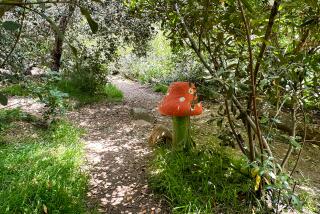English Landscape Is Losing Cherished Hedges
- Share via
NASH, England — Unkempt about those hedges blows
An English unofficial rose.
--Rupert Brooke, “The Old Vicarage, Grantchester,” 1912
A hedge-lined lane winding through a patchwork of fields and meadows is the essence of the English countryside--intimate, unspectacular and dearly loved.
“It’s part of our heritage, really,” said Chris Phillips, who tends about 10 miles of hedge at his Buckinghamshire farm.
“We, as farmers, are responsible for looking after the countryside.”
But thousands of miles of hedgerows, many set out in Saxon times, have been lost to modern farming methods and urban encroachment. Since 1978, more than one-fifth of the country’s hedges have disappeared, at an annual rate of 4,000 miles in recent years.
To stem the loss, the government stepped in this summer with $5.9 million in grants for farmers who agree to a 10-year program of hedgerow restoration and maintenance.
A bill due in Parliament in January would require local government approval to remove a hedge.
At his farm on the edge of Nash, a village about 50 miles northwest of London, Phillips welcomed the grants.
“It’s expensive to maintain something that isn’t providing a contribution to the running of the business financially,” he said.
Phillips, his wife, Shirley, and three children like to take their vacations in parts of the country “always with rolling hills, big hedges, plenty of woodlands and lovely little nestling English villages. It’s really smashing, and I’m determined to make my bit of the countryside look the same.”
The hedgerow is one of those rare human contributions to nature, giving back more than it takes.
There, in a thicket of hawthorn or blackthorn, live the hedgehog and the field vole, the wren and the song thrush. There caterpillars become butterflies, and wildflowers driven from the fields by modern agriculture cling to life at the edge of the road.
Hedgerows form corridors for mice and other meadow creatures, and so become hunting grounds for kestrels and barn owls.
In May, the hawthorn hedges foam with white blossoms. In summer, honeysuckle twines among the twigs, and dog roses brighten the roadside. In autumn, the shrubs produce berries to feed the birds and voles.
“I think the English would regard hedges as part of our cultural heritage,” said Tim Allen of the Countryside Commission, which oversees the grant program.
“Because there are lots of different types, they also help to give a distinctive sense of place,” he said. “In Devon, you see hedges on stone-faced earth banks and it says to you, ‘This is Devon.’
“And if you lose the hedge, you lose the wildlife of the hedge, and the effects go up the food chain.”
When the Saxons cleared fields 1,000 years ago, they left some hedges on the woodland margins.
“Some may be much older than that,” Allen said. “There’s every possibility they date to Roman times.”
As common land was enclosed in the 16th, 17th and 18th centuries, hedges marked boundaries, restricted livestock, gave shelter and shade to man and beast and protected crops from the wind.
Then, with mechanization, farmers began removing hedges to open up their small fields for more efficient use of tractors and combines.
In the ideal hedge for wildlife, some of the saplings are left to grow to maturity, while the thickets on either side are regularly trimmed to keep them dense.
Neglecting a hedgerow is nearly as bad as rooting it out, said Derek Niemann of the Royal Society for the Protection of Birds.
The society has begun a campaign to reverse the destruction of wildlife habitats, including hedges. It says nearly one-third of farmland bird species are at risk, including skylarks, the barn owl and the gray partridge, which has declined by 78% since World War II.
A properly managed hedgerow must be trimmed, and some need to be coppiced--cut back hard so they can regenerate.
Others, which have been allowed to grow tall and gappy, should be “layed”--a demanding procedure that involves slicing the main stems of young trees down toward the base to make them pliable, then bending them horizontally and weaving them together. New shoots will grow from the horizontal stems, filling in the gaps.
The government will pay farmers $3.40 a yard for laying, $2.60 for coppicing, $42.50 for restoring of stone-faced banks and smaller amounts for other work. A farmer is paid $1.10 for each hedgerow tree planted.
The National Farmers’ Union welcomed the grants, but believes more money should be devoted to the project.
“Ecologists and countryside users see hedgerows as things of beauty, a leafy line full of birds, laden with fruit and providing cover for mammals,” said Melinda Appleby, the union’s environmental adviser. “Farmers see them in terms of management.
“There is a cost, and if they don’t have an agricultural function, farmers are paying out year after year for no return.”
More to Read
Sign up for Essential California
The most important California stories and recommendations in your inbox every morning.
You may occasionally receive promotional content from the Los Angeles Times.













